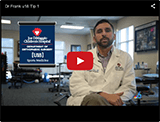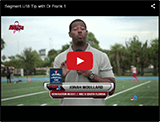Ankle Sprain
A sprain is stretching or tearing of ligaments, which connect adjacent bones in a joint and provides stability to the joint. An ankle sprain is a common injury and occurs when you fall or suddenly twist the ankle joint or when you land your foot in an awkward position after a jump. It most commonly occurs when you participate in sports or when you jump or run on a surface that is irregular. Ankle sprains can cause pain, swelling, tenderness, bruising, and stiffness, numbness in the toes, and inability to walk or bear weight on the ankle.
The diagnosis of an ankle sprain is usually made by asking the history of injury and physical examination of the ankle. X-ray of your ankle may be needed to confirm if a fracture is present.
The most common treatment recommended for ankle sprains is rest, ice, compression and elevation (RICE).
- Rest: You should not move or use the injured part to help to reduce pain and prevent further damage. Crutches may be used that help in walking.
- Ice: An ice-pack should be applied over the injured area up to 3 days after the injury. You can use a cold pack or crushed ice wrapped in a towel. Ice packs helps to reduce swelling and relieve pain. Never place ice directly over the skin.
- Compression: Compression of the injured area helps to reduce swelling and bruising. This is usually accomplished by using an elastic wrap for few days to weeks after the injury.
- Elevation: Place the injured part above heart level to reduce swelling. Elevation of an injured leg can be done for about 2 to 3 hours a day.
The doctor may also use a brace or splint to reduce motion of the ankle. Anti-inflammatory pain medications may be prescribed to help reduce the pain and control inflammation.
You may need to use an ankle brace or wrap to support and protect your ankle during sports activities. Avoid pivoting and twisting movements for 2 to 3 weeks.
To prevent further sprains or re-injury you may need to wear a semi-rigid ankle brace during exercise, special wraps, and high-top tennis shoes. A program of ankle exercises will also help to prevent re-injury by making the ankles strong and flexible.
-
Personalized Physical Therapy Puts Bryant Back on the Court
Bryant could hear the whistles blowing as he walked by the gymnasium.
View more -
No off-season for sports injuries
As a new season of school sports and youth leagues gets underway,
View more -
Student Athletes Benefit from Individualized Treatment at U18 Sports Medicine
Becoming involved in a sport is one of the healthiest things that a child can do.
View more -
For young athletes, injuries need special care
More programs are using procedures and surgical techniques tailored for kids.
View more -
Dr Frank u18 Tip 1
 View more
View more -
Segment U18 Tip with Dr Frank 1
 View more
View more -
Dr. Frank’s 2010 WQAM high school football game halftime interviews
View more




 Menu
Menu






 In The News
In The News Hollywood Office
Hollywood Office

![[U18] Sports Medicine](https://www.kidbones.net/wp-content/themes/ypo-theme/images/u18-sports-medicine-performing-arts-logo.png)












